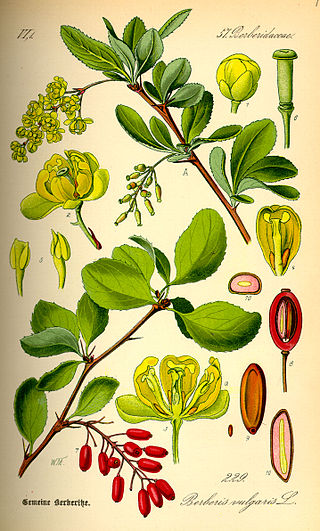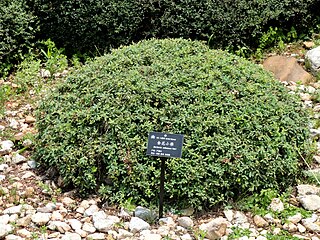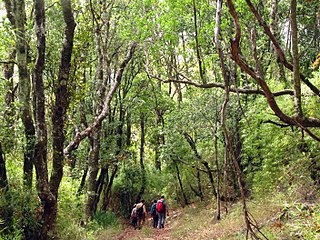
A shrub or bush is a small-to-medium-sized perennial woody plant. Unlike herbaceous plants, shrubs have persistent woody stems above the ground. Shrubs can be either deciduous or evergreen. They are distinguished from trees by their multiple stems and shorter height, less than 6–10 m (20–33 ft) tall. Small shrubs, less than 2 m (6.6 ft) tall are sometimes termed as subshrubs. Many botanical groups have species that are shrubs, and others that are trees and herbaceous plants instead.

Berberis aquifolium, the Oregon grape or holly-leaved barberry, is a species of flowering plant in the family Berberidaceae, native to western North America. It is an evergreen shrub growing 1–3 meters tall and 1.5 m (5 ft) wide, with pinnate leaves consisting of spiny leaflets, and dense clusters of yellow flowers in early spring, followed by dark bluish-black berries.

Mahonia is a formerly accepted genus of approximately 70 species of shrubs or, rarely, small trees with evergreen leaves in the family Berberidaceae, native to eastern Asia, the Himalaya, North America, and Central America. They are closely related to the genus Berberis and as of 2023 the majority of botanical sources list it as a synonym for Berberis.

Berberis, commonly known as barberry, is a large genus of deciduous and evergreen shrubs from 1–5 m (3.3–16.4 ft) tall, found throughout temperate and subtropical regions of the world. Species diversity is greatest in South America and Asia; Europe, Africa and North America have native species as well. The best-known Berberis species is the European barberry, Berberis vulgaris, which is common in Europe, North Africa, the Middle East, and central Asia, and has been widely introduced in North America. Many of the species have spines on the shoots and all along the margins of the leaves.

The Berberidaceae are a family of 18 genera of flowering plants commonly called the barberry family. This family is in the order Ranunculales. The family contains about 700 known species, of which the majority are in the genus Berberis. The species include trees, shrubs and perennial herbaceous plants.

Berberis microphylla, common name box-leaved barberry and Magellan barberry, in Spanish calafate and michay and other names, is an evergreen shrub, with simple, shiny box-like leaves. The calafate is native to southern Argentina and Chile and is a symbol of Patagonia. Berberis microphylla should not be confused with Mahonia microphylla, native to China.

Berberis pinnata is a species of shrub in the barberry family. Common names include California barberry, wavyleaf barberry, and shinyleaf mahonia. It is similar to the Oregon-grape, and is sometimes called the California Oregon-grape.

Berberis darwinii, Darwin’s barberry, is a species of flowering plant in the family Berberidaceae, native to southern Chile and Argentina and naturalized elsewhere. Regional vernacular names include michay, calafate, and quelung. Growing to 3–4 m (9.8–13.1 ft) tall, it is an evergreen thorny shrub.

Berberis vulgaris, also known as common barberry, European barberry or simply barberry, is a shrub in the genus Berberis native to the Old World. It produces edible but sharply acidic berries, which people in many countries eat as a tart and refreshing fruit.

Berberis repens commonly known as creeping mahonia, creeping Oregon grape, or creeping barberry, is a species of Berberis native to most of the western United States and two western provinces of Canada. It has found use as a xeric ornamental plant and has escaped from cultivation in areas beyond its native range.

Berberis trifoliolata is a species of flowering plant in the family Berberidaceae, in southwestern North America. Common names include agarita, agrito, algerita, currant-of-Texas, wild currant, and chaparral berry. The name Agarita comes from the Spanish verb agarrar, which means "to grab". The ending "-ita" is often added to little things, so agarita means "grabs a little". This was probably said because the bush is a bit scratchy but does not have significant spines. Typical characteristics are grey-green to blue-grey leaves, yellow flowers in February to April and the red berries appearing in May. The most important harvest organ are the berries, though the roots and seeds can also be used.

The native flora of Chile is characterized by a higher degree of endemism and relatively fewer species compared to the flora of other countries of South America. A classification of this flora necessitates its division into at least three general zones: the desert provinces of the north, Central Chile, and the humid regions of the south.

Berberis nevinii, known by the common name Nevin's barberry, is a species of flowering shrub in the barberry family.

Berberis japonica is a species of flowering plant in the family Berberidaceae, native to Taiwan. Despite the name, it is not native to Japan, though it has been known in cultivation there for centuries. The wild origins of this species have long puzzled botanists, but wild plants in Taiwan, previously known under the name Mahonia tikushiensis, appear most similar to the cultivated forms of B. japonica.

Berberis valdiviana is a species of flowering plant in the barberry family Berberidaceae. It is an evergreen shrub endemic to Chile, where it is locally known as cien or espina en cruz. The Latin specific name valdiviana refers to the Valdivia Province of Chile. It has simple, dark green, pointed leaves, glossy on the upper surfaces, up to 8.5 cm (3.3 in) long. The flowers, which appear in May, are grouped in hanging racemes. Individual flowers are orange, 5–8 mm (0.2–0.3 in) across, and are followed by purplish fruits. It is grown as an ornamental plant, but is not suitable for colder regions.

Berberis ilicifolia, sometimes called holly barberry or holly-leaved barberry is a medium to high, spiny shrub belonging to the barberries in the family Berberidaceae. The local name in Chile is Chelia. It has ovate leaves with a few teeth that end in spines, reminiscent of holly leaves. Its orange flowers grow with three to seven together, which later produce globose blue-black berries. The species is native to south of 40ºS in Argentina and Chile, where it grows in Nothofagus woods. Flowers are present from August to December, while ripe berries are available between November and March.

Chiliotrichum diffusum is a species of small shrub, a flowering plant in the family Asteraceae, commonly known as fachine, fascine or mata verde in Spanish. It is native to the southern tip of South America and the Falkland Islands.
Franz Wilhelm Neger was a German botanist, mycologist and dendrologist.

Berberis wilsoniae, Mrs. Wilson's barberry, is a species of flowering plant in the family Berberidaceae. It is native to Tibet, south-central China, and Myanmar, and has been introduced to the North and South Islands of New Zealand. It is a mound-forming, deer-resistant shrub, with blueish-green leaves that turn red in Autumn and yellow flowers that produce translucent pink fruit. A number of cultivars are available.

Nonguén National Park is a protected area in central Chile. It is located in Bío Bío Region, southeast of the city of Concepción. It was designated a national reserve in 2010, and re-designated a national park in 2021. It protects an area of 30.37 km2.

















